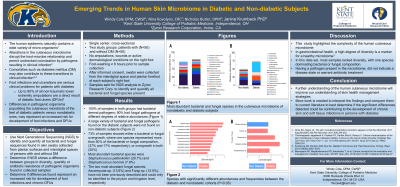Clinical Research
(CR-016) Emerging Trends in Human Skin Microbiome in Diabetic and Non-diabetic Subjects

The skin is an ecosystem that contains a wide variety of micro-organisms. Alterations in the cutaneous microbiome not only disrupt the host-microbe relationship but can permit unchecked cutaneous colonization by pathogens. The aim of this study was to determine if there is a detectable difference in the microbiome between people with and without diabetes that could be a contributing factor in the development of skin and soft tissue infections in people with diabetes.
Methods:
This single center, analytical, cross-sectional study compared the cutaneous microbiome of the right plantar forefoot and interdigital spaces (IDS) of 100 subjects. N=50 with and N=50 without diabetes. Skin swabs were analyzed using Next Generation Sequencing (NGS) to identify and quantify all bacterial sequences.
Results:
The microbiome of non-diabetic and diabetic patients was substantially similar across both sampling sites (IDS and plantar region), both in frequency of detection and relative abundance. Across cohorts, Corynebacterium pseudogenitalium-tuberculostearicum was the most frequently detected microbe, found in 98% of IDS healthy (with an average of 13.58% relative abundance) and plantar healthy samples (with a relative abundance of 4.92%) and 96% of IDS diabetic samples (with a relative abundance of 14.82%) and plantar diabetic samples (with a relative abundance of 5.47%).
The bacterial species with the largest relative abundance, regardless of sample location and diabetic status of the patient, was Staphylococcus pettenkoferi. Additionally, there was a significant decrease in Cutebacterium acnes when comparing healthy individuals (1,254,473 estimated cells in healthy IDS and 4561,146 cells in the healthy plantar to 41,223 cells in diabetic IDS and 13,374 cells in diabetic plantar regions; p value = 1.68x10-7).
Discussion:

.jpeg)